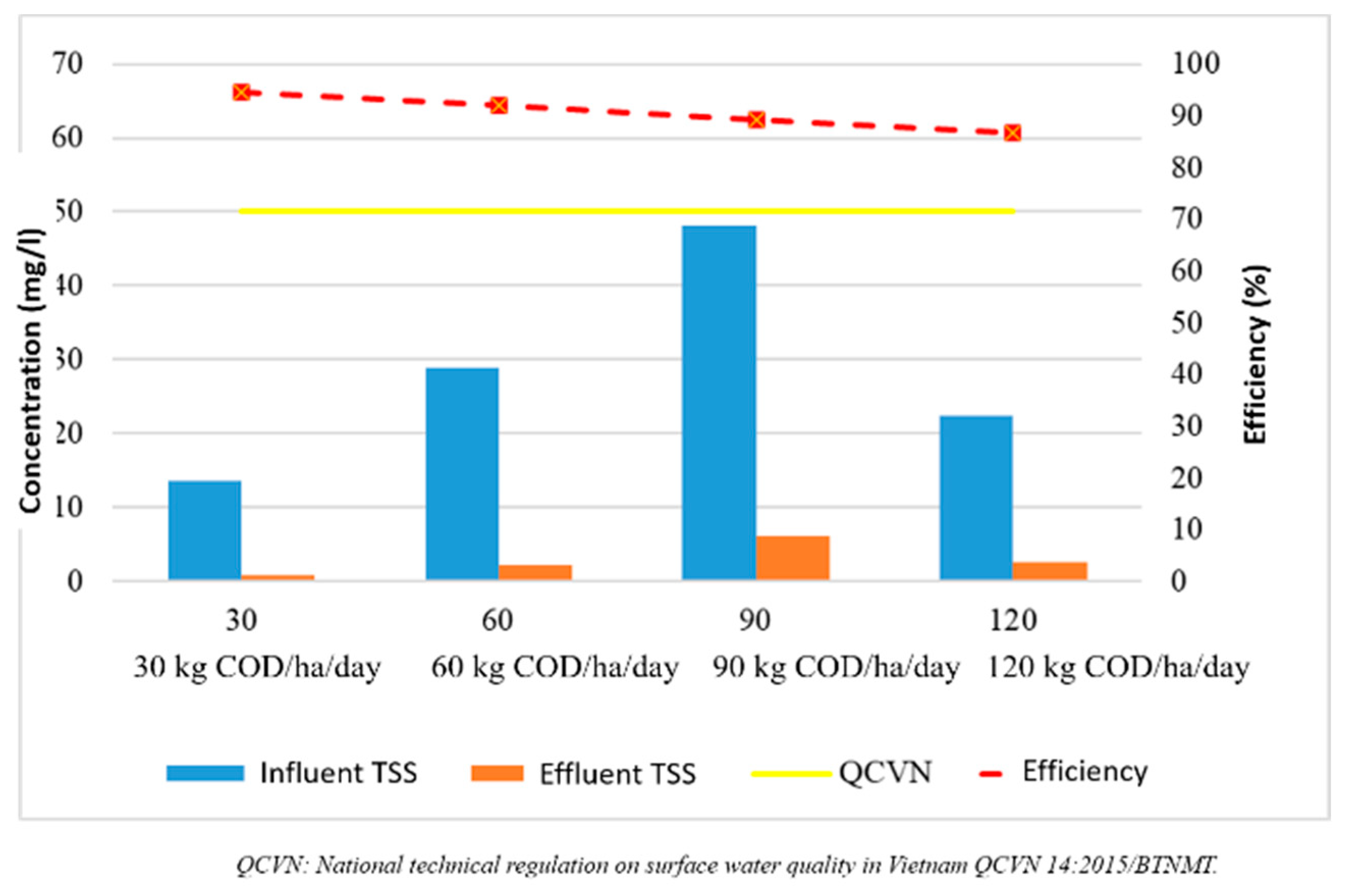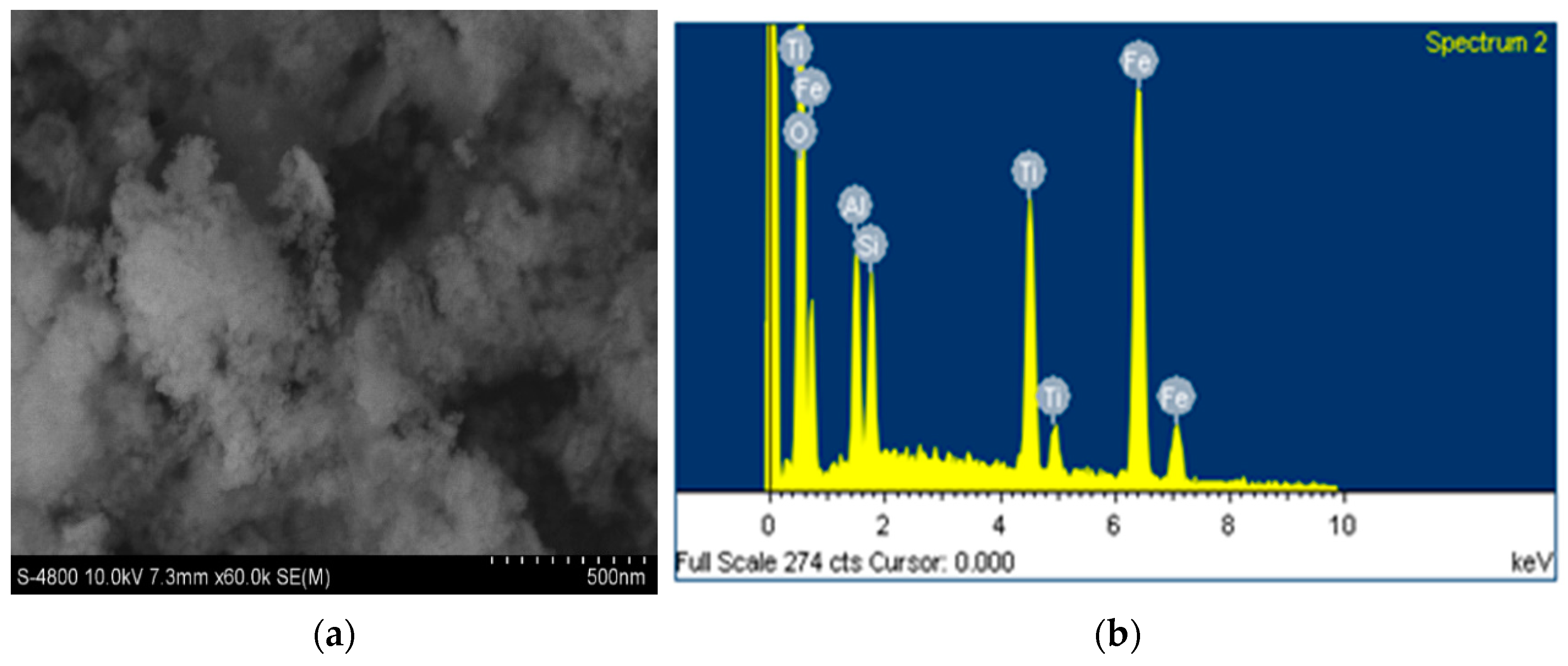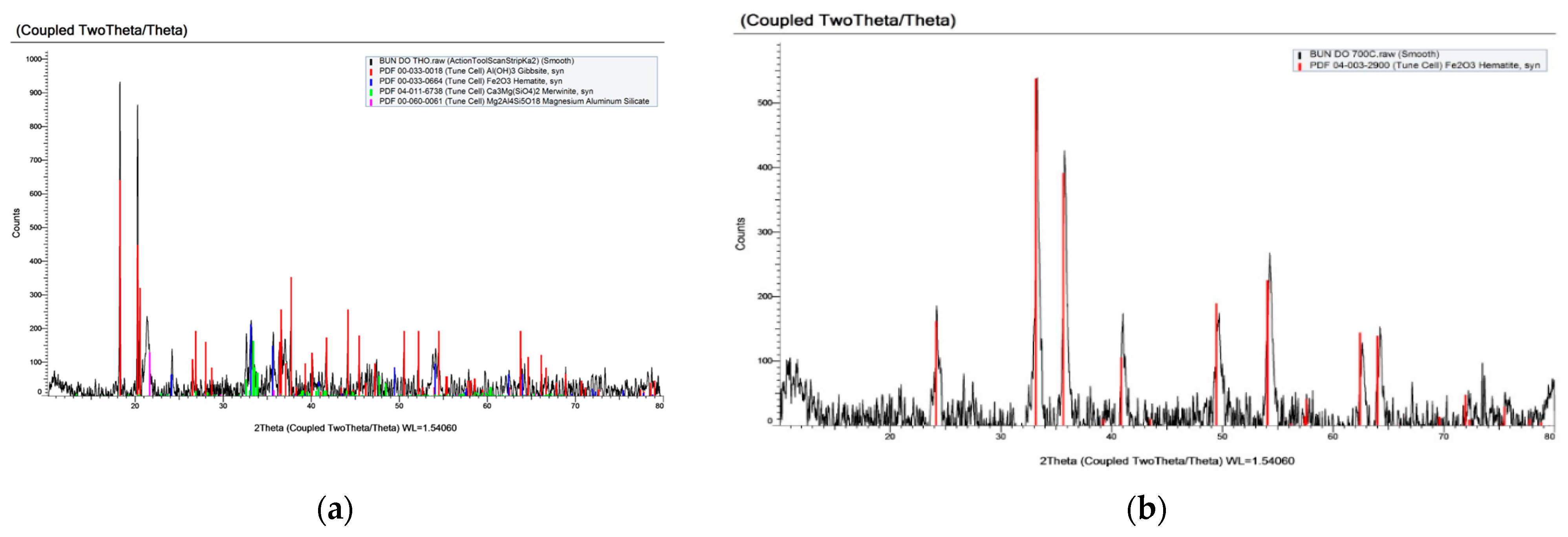Domestic Wastewater Treatment Using Constructed Wetland with Para Grass Combined with Sludge Adsorption, Case Study in Vietnam: An Efficient and Alternative Way
Abstract
:1. Introduction
2. Experimental Section
2.1. Constructed Wetlands Model
2.2. Operation Period
2.3. Activation of Red Mud
2.4. Study on Domestic Wastewater Treatment Using Constructed Wetland Combined with Sludge Adsorption
2.5. Material Characterization
3. Results and Discussion
3.1. Domestic Wastewater Treatment Using Constructed Wetland
3.1.1. COD Removal Efficiency
3.1.2. Nitrogen Total Removal Efficiency
3.1.3. Phosphorous Total Removal Efficiency
3.1.4. Total Suspended Solids (TSS) Removal Efficiency
3.1.5. Coliform Removal Efficiency
3.2. Domestic Wastewater Treatment Using Constructed Wetland Combined with Adsorption of Red Sludge
3.3. Analysis of Accumulated N, P Content in Para Grass
4. Conclusions
Author Contributions
Funding
Institutional Review Board Statement
Informed Consent Statement
Data Availability Statement
Conflicts of Interest
References
- Vymazal, J. Horizontal Sub-Surface Flow and Hybrid Constructed Wetlands Systems for Wastewater Treatment. Ecol. Eng. 2005, 25, 478–490. [Google Scholar] [CrossRef]
- Masi, F.; Martinuzzi, N. Constructed Wetlands for the Mediterranean Countries: Hybrid Systems for Water Reuse and Sustainable Sanitation. Desalination 2007, 215, 44–55. [Google Scholar] [CrossRef]
- Gaboutloeloe, G.K.; Chen, S.; Barber, M.E.; Stöckle, C.O. Combinations of Horizontal and Vertical Flow Constructed Wetlands to Improve Nitrogen Removal. Water Air Soil Pollut. Focus 2009, 9, 279–286. [Google Scholar] [CrossRef]
- Juntasin, W.; Imura, Y.; Nakamura, I.; Hossain, M.A.; Thaikua, S.; Poungkaew, R.; Kawamoto, Y. Effects of Closing Cut Date and Nitrogen Fertilization on Seed Yield and Seed Quality in Two Novel Cultivars of Urochloa spp. Agronomy 2022, 12, 513. [Google Scholar] [CrossRef]
- An, B.X. Study on the Ability to Treat Pig Breeding Wastewater of Some Aquatic Plants in Ho Chi Minh City; HCMC Department of Science and Technology: Ho Chi Minh City, Vietnam, 2013. [Google Scholar]
- Nam, H.D.; Nam, N.N. Study on Industrial Wastewater Treatment Process by Microorganism; HCMC Department of Science and Technology: Ho Chi Minh City, Vietnam, 2014. [Google Scholar]
- Van Thu, N. Using Water Hyacinth Results Compared with Hydrolyzed Straw and Turf Grass for the Production of Biogas in Invitro Condition. Proc. Sci. Can Tho Univ. 2010. [Google Scholar]
- Handley, L.L.; Ekern, P.C. Effluent irrigation of para grass: Water, nitrogen, and biomass budgets. J. Am. Water Resour. Assoc. 1984, 20, 669–677. [Google Scholar] [CrossRef]
- Ashraf, S.; Afzal, M.; Rehman, K.; Naveed, M.; Zahir, Z.A. Plant-Endophyte Synergism in Constructed Wetlands Enhances the Remediation of Tannery Effluent. Water Sci. Technol. 2018, 77, 1262–1270. [Google Scholar] [CrossRef]
- Schmitz, C. Handbook of Aluminium Recycling: Fundamentals: Mechanical Preparation Metallurgical Processing Plant Design; Vulkan-Verlag GmbH: Essen, Germany, 2006. [Google Scholar]
- Wang, M.; Liu, X. Applications of Red Mud as an Environmental Remediation Material: A Review. J. Hazard. Mater. 2021, 408, 124420. [Google Scholar] [CrossRef]
- Koumanova, B.; Drame, M.; Popangelova, M. Phosphate Removal from Aqueous Solutions Using Red Mud Wasted in Bauxite Bayer’s Process. Resour. Conserv. Recycl. 1997, 19, 11–20. [Google Scholar] [CrossRef]
- Cengeloglu, Y.; Tor, A.; Ersoz, M.; Arslan, G. Removal of Nitrate from Aqueous Solution by Using Red Mud. Sep. Purif. Technol. 2006, 51, 374–378. [Google Scholar] [CrossRef]
- Huang, W.; Wang, S.; Zhu, Z.; Li, L.; Yao, X.; Rudolph, V.; Haghseresht, F. Phosphate Removal from Wastewater Using Red Mud. J. Hazard. Mater. 2008, 158, 35–42. [Google Scholar] [CrossRef] [PubMed]
- Xie, W.; Zhou, F.; Liu, J.; Bi, X.; Huang, Z.; Li, Y.; Chen, D.; Zou, H.; Sun, S. Synergistic Reutilization of Red Mud and Spent Pot Lining for Recovering Valuable Components and Stabilizing Harmful Element. J. Clean. Prod. 2020, 243, 118624. [Google Scholar] [CrossRef]
- Xu, Y.; Yang, B.; Liu, X.; Gao, S.; Li, D.; Mukiza, E.; Li, H. Investigation of the Medium Calcium Based Non-Burnt Brick Made by Red Mud and Fly Ash: Durability and Hydration Characteristics. Int. J. Miner. Metall. Mater. 2019, 26, 983–991. [Google Scholar] [CrossRef]
- Zhao, Y.; Liang, N.; Chen, H.; Li, Y. Preparation and Properties of Sintering Red Mud Unburned Road Brick Using Orthogonal Experiments. Constr. Build. Mater. 2020, 238, 117739. [Google Scholar] [CrossRef]
- Mukiza, E.; Zhang, L.; Liu, X.; Zhang, N. Utilization of Red Mud in Road Base and Subgrade Materials: A Review. Resour. Conserv. Recycl. 2019, 141, 187–199. [Google Scholar] [CrossRef]
- Hertel, T.; Pontikes, Y. Geopolymers, Inorganic Polymers, Alkali-Activated Materials and Hybrid Binders from Bauxite Residue (Red Mud)—Putting Things in Perspective. J. Clean. Prod. 2020, 258, 120610. [Google Scholar] [CrossRef]
- Li, Y.; Min, X.; Ke, Y.; Liu, D.; Tang, C. Preparation of Red Mud-Based Geopolymer Materials from MSWI Fly Ash and Red Mud by Mechanical Activation. Waste Manag. 2019, 83, 202–208. [Google Scholar] [CrossRef]
- Kazak, O.; Tor, A. In Situ Preparation of Magnetic Hydrochar by Co-Hydrothermal Treatment of Waste Vinasse with Red Mud and Its Adsorption Property for Pb(II) in Aqueous Solution. J. Hazard. Mater. 2020, 393, 122391. [Google Scholar] [CrossRef]
- Thanh Ho, V.T.; Dang, M.P.; Lien, L.T.; Huynh, T.T.; van Hung, T.; Bach, L.G. Study on Domestic Wastewater Treatment of the Horizontal Subsurface Flow Wetlands (HSSF-CWs) Using Brachiaria Mutica. Waste Biomass Valorization 2020, 11, 5627–5634. [Google Scholar] [CrossRef]
- Ho, V.T.T.; Hoang, N.D.; Pham, M.D. Determining the Growth and Wastewater Treatment Ability of Para Grass (Brachiaria Mutica) Vegetation in the Stabilization Ponds. In Emerging Challenges in Environment and Earth Science; Book Publisher International (a part of SCIENCEDOMAIN International): West Bengal, India, 2021; Volume 1, pp. 83–90. [Google Scholar]
- Tor, A.; Cengeloglu, Y.; Aydin, M.E.; Ersoz, M. Removal of Phenol from Aqueous Phase by Using Neutralized Red Mud. J. Colloid Interface Sci. 2006, 300, 498–503. [Google Scholar] [CrossRef]
- Gupta, V.K.; Ali, I.; Saini, V.K. Removal of Chlorophenols from Wastewater Using Red Mud: An Aluminum Industry Waste. Environ. Sci. Technol. 2004, 38, 4012–4018. [Google Scholar] [CrossRef] [PubMed]








| Organic Loading | 120 kgCOD/ha/day | |||||
|---|---|---|---|---|---|---|
| No. | 1 | 2 | 3 | 4 | 5 | |
| pH | Input wastewater | 7.3 | 7.4 | 7.4 | 7.5 | 7.5 |
| Output wastewater after treatment 1 | 7.6 | 7.6 | 7.1 | 7.2 | 7.2 | |
| Output wastewater after treatment 2 | 7.6 | 7.6 | 7.1 | 7.2 | 7.2 | |
| COD (mg/L) | Input wastewater | 139.54 | 160.16 | 174.72 | 180.54 | 188.62 |
| Output wastewater after treatment 1 | 26.82 | 29.56 | 32.12 | 33.4 | 35.6 | |
| Output wastewater after treatment 2 | 15.2 | 18.85 | 20.06 | 18.24 | 27.64 | |
| TN (mg/L) | Input wastewater | 58.5 | 50.35 | 53 | 55.67 | 55.67 |
| Output wastewater after treatment 1 | 25.1 | 21.6 | 21.25 | 22.32 | 22.2 | |
| Output wastewater after treatment 2 | 19.4 | 16.9 | 16.7 | 17.2 | 18.5 | |
| TP (mg/L) | Input wastewater | 15.2 | 17 | 13.9 | 17.5 | 20.9 |
| Output wastewater after treatment 1 | 2.7 | 2.8 | 2.3 | 2.9 | 3.4 | |
| Output wastewater after treatment 2 | N/A | N/A | N/A | N/A | N/A | |
| TSS (mg/L) | Input wastewater | 37.65 | 27.75 | 15.75 | 12.57 | 18.35 |
| Output wastewater after treatment 1 | 3.2 | 2.8 | 2.3 | 2.1 | 3.01 | |
| Output wastewater after treatment 2 | 0.1 | N/A | N/A | N/A | N/A | |
| Coliform (MPN/100 mL) | Input wastewater | 240,000 | 230,000 | 240,000 | 240,000 | 230,000 |
| Output wastewater after treatment 1 | 1910 | 1855 | 2520 | 3110 | 3750 | |
| Output wastewater after treatment 2 | 1910 | 1855 | 2520 | 3110 | 3750 | |
| Analytical Indicators | Grass Component | % | Concentration (mg/g) |
|---|---|---|---|
| TN | Grass root | 4.02 | 40.15 |
| Grass stalks | 3.86 | 38.61 | |
| Grass leaves | 2.12 | 21.24 | |
| TP | Grass root | 0.31 | 3.11 |
| Grass stalks | 0.41 | 4.07 | |
| Grass leaves | 0.28 | 2.82 |
Publisher’s Note: MDPI stays neutral with regard to jurisdictional claims in published maps and institutional affiliations. |
© 2022 by the authors. Licensee MDPI, Basel, Switzerland. This article is an open access article distributed under the terms and conditions of the Creative Commons Attribution (CC BY) license (https://creativecommons.org/licenses/by/4.0/).
Share and Cite
Ho, V.T.T.; Bui, K.Q.; Le, D.V.; Chau, D.H.; Hoang, B.N.; Pham, H.T.; Nguyen, A.T. Domestic Wastewater Treatment Using Constructed Wetland with Para Grass Combined with Sludge Adsorption, Case Study in Vietnam: An Efficient and Alternative Way. Processes 2022, 10, 2636. https://doi.org/10.3390/pr10122636
Ho VTT, Bui KQ, Le DV, Chau DH, Hoang BN, Pham HT, Nguyen AT. Domestic Wastewater Treatment Using Constructed Wetland with Para Grass Combined with Sludge Adsorption, Case Study in Vietnam: An Efficient and Alternative Way. Processes. 2022; 10(12):2636. https://doi.org/10.3390/pr10122636
Chicago/Turabian StyleHo, Van Thi Thanh, Khang Quang Bui, Dien Vinh Le, Dung Hung Chau, Bich Ngoc Hoang, Huong Thi Pham, and Anh Tuan Nguyen. 2022. "Domestic Wastewater Treatment Using Constructed Wetland with Para Grass Combined with Sludge Adsorption, Case Study in Vietnam: An Efficient and Alternative Way" Processes 10, no. 12: 2636. https://doi.org/10.3390/pr10122636





